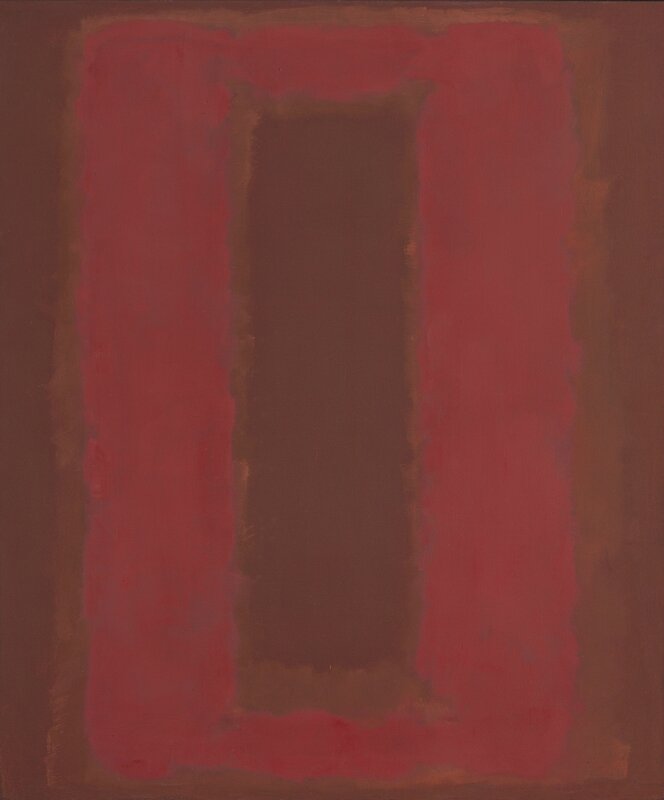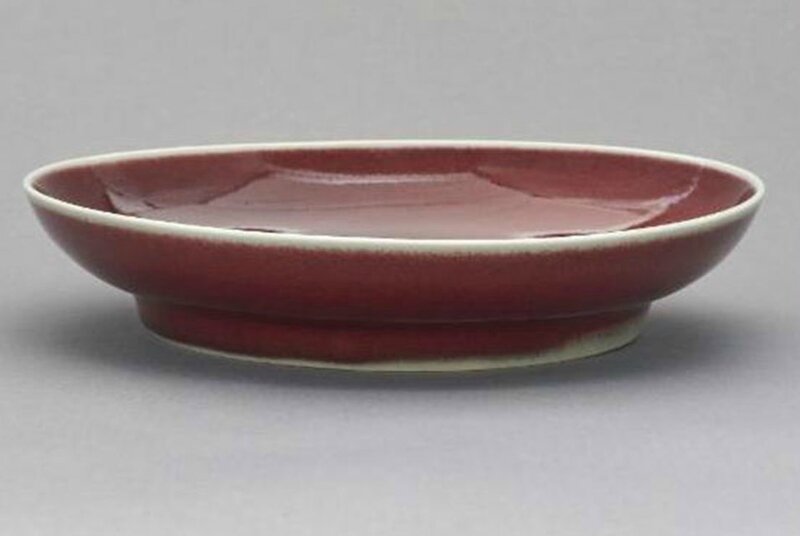Powerful color unites a rare dish and a Rothko painting at the Smithsonian's Sackler Gallery
Untitled - Seagram Mural sketch; Painting; Artist: Mark Rothko; 1959; Oil and acrylic on canvas; Gift of the Mark Rothko Foundation, Inc.; National Gallery of Art; ELS2016.8.2.
Dish with copper-red glaze; China, Jiangxi province, Jingdezhen; Ming dynasty, Xuande (1426-35) mark and period; Porcelain with copper-red glaze; on the base, a six-character cobalt-oxide (blue) reign mark in a double circle under colorless glaze; Purchase-Freer Endowment and Friends of the Freer and Sackler Galleries F2015.2.
WASHINGTON, DC.- Brought together for the first time in an unexpected juxtaposition, an imperial Chinese porcelain dish and a Mark Rothko (1903-1970) painting reveal the profundity of the color red. The exhibition, "Red: Ming Dynasty/Mark Rothko," will be on view at the Arthur M. Sackler Gallery Sept. 3-Feb. 20, 2017. This unprecedented pairing of two objects created more than five centuries apart demonstrates that the power of color transcends time and place.
The exhibition marks the debut of this Ming dynasty dish, a new acquisition for the museum. The dish, a rare Xuande period (1425-36) treasure, is the first copper-red-glazed porcelain to become a part of the permanent collection. Monochrome porcelains are among the greatest achievements in ceramics, and no color is more complex to create and more coveted than the luscious copper-red glaze of this period. The dish's velvety texture and variegated reds evoke crushed raspberries and parallel Rothko's tactile use of richly layered pigment on canvas.
Working centuries after the Ming potters in a different mindset, Rothko developed his own complex way of handling red pigments. His "Untitled (Seagram Mural Sketch)" of 1959, on loan from the National Gallery of Art in Washington, D.C., is an oil-and-acrylic painting created when Rothko accepted a commission to decorate the dining room of the Four Seasons restaurant in Manhattan--a plan from which he ultimately withdrew. For the project, Rothko favored a palette of dark wine reds and browns, overlaying the pigments to create a surface that echoes the plush, luminous glaze of the Xuande dish.
The color red is universally symbolic and is nowhere as celebrated as in China, but the exhibition intentionally separates the artworks from their historical context, instead celebrating the visual dialogue that this pairing puts into play. It is an opportunity to meditate on the abstract qualities of red and enjoy the uncanny resonance of these artworks.
"Rothko believed that art could transform the public--he was hoping to engender big emotions in his viewer--tragedy, ecstasy and doom," said exhibition curator Jan Stuart, the museum's Melvin R. Seiden Curator of Chinese Art. "The Ming potters had a different mindset--they were making a ritual ware for the emperor, and yet they worked with the same visual concerns--how to achieve an alchemy of color, texture, shape and edge. Rothko painted the edge of this canvas, while the Ming potters left the rim of the dish white to contrast with the red. In the end, the dish and painting together leave you weeping with the beauty of red."
"Red: Ming Dynasty/Mark Rothko," advocates the museum founder Charles Lang Freer's (1854-1919) love for "quiet contemplation and intelligent comparison." When seen together, the exhibition creates a one-time chance for a unique and contemplative experience. After the exhibition, the dish will enter the Smithsonian's Freer Gallery of Art--upon its reopening in 2017--and be displayed among other imperial artworks of its time. Simultaneously, the Rothko will return to the National Gallery.

/https%3A%2F%2Fprofilepics.canalblog.com%2Fprofilepics%2F1%2F0%2F100183.jpg)
/https%3A%2F%2Fstorage.canalblog.com%2F03%2F02%2F119589%2F96711876_o.jpg)
/https%3A%2F%2Fstorage.canalblog.com%2F11%2F31%2F119589%2F94773502_o.jpg)
/https%3A%2F%2Fstorage.canalblog.com%2F20%2F83%2F119589%2F94772815_o.jpg)
/https%3A%2F%2Fstorage.canalblog.com%2F26%2F72%2F119589%2F75604929_o.jpg)
/https%3A%2F%2Fstorage.canalblog.com%2F59%2F60%2F119589%2F26458628_o.jpg)




/http%3A%2F%2Fstorage.canalblog.com%2F77%2F91%2F119589%2F129002761_o.jpg)
/http%3A%2F%2Fstorage.canalblog.com%2F05%2F93%2F119589%2F128701538_o.jpg)
/http%3A%2F%2Fstorage.canalblog.com%2F43%2F03%2F119589%2F120591332_o.jpg)
/http%3A%2F%2Fstorage.canalblog.com%2F98%2F10%2F119589%2F120397015_o.jpg)